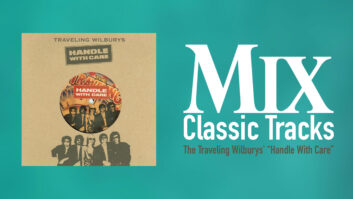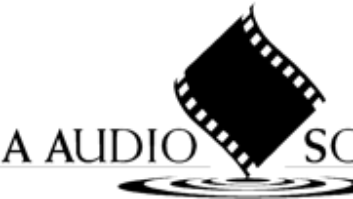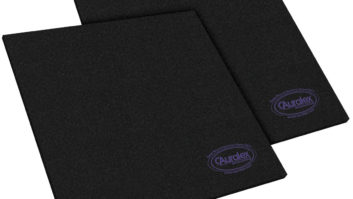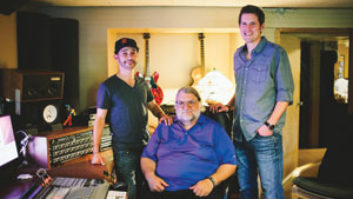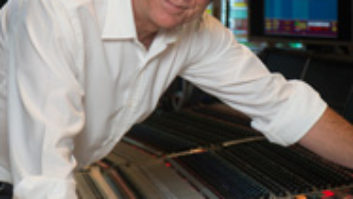
The career of engineer, producer and mixer Richard Dodd has taken many interesting twists and turns over the past three decades. Since the early ’70s, when he was recording hits like Carl Douglas’ “Kung Fu Fighting,” Dodd has worked with the likes of George Harrison, Roy Orbison, Boz Scaggs, Wilco, Green Day, Steve Earle, Delbert McClinton, Robert Plant, the Traveling Wilburys, Clannad, Tom Petty & The Heartbreakers (Grammy™ nomination for Echo) and Petty’s solo album Wildflowers (which earned Dodd a “Best Engineer” Grammy). After nearly 15 years, Dodd’s longest ongoing creative relationship has been with Petty, culminating in the artist’s newest release, The Last DJ.
In the interview that follows, Dodd, an Englishman who now lives in Nashville, shares a number of provocative thoughts on issues facing the industry today, as well as some insight into his methods in the studio.
Tom Petty’s latest album,The Last DJ, was a strong statement against many of the ills he believes permeate the music industry.
The first time I heard it, a big smile came over my face and I thought, “Yeah, go for it, Tom! Good for you!” Not many would have the balls to say some of that stuff.
In this age of computerized and automated everything, you still enjoy the challenge of manual mixing wherever it makes sense. I understand that the latest Petty album was largely done with manual mixes.
That’s right. When we started mixing The Last DJ, we started with the intention of using automation. The majority of the board, which was a classic old Neve at Cello Studios in Los Angeles, had automation, while the monitor section didn’t. Three of the songs on the album used significantly more than 24 tracks, because they involved orchestra. So I set up the console to leave the orchestra on the monitor section and had it submixed onto the automated side of the console. George Drakoulias, the producer, was very busy with the monitor faders during playback and eventually said, “I wish we could mix on the monitor side,” so we did with the rest of the album. Only the overflow of the 24 tracks and effects returns went through the automated side of the console. As a result, the mixing went a lot faster. [Laughs] It made the process immediately a lot less tiring for those involved.
Today, however, mixing manually is more the exception than the rule. It’s the exception, because it requires a very strong artist/producer/engineer relationship and an understanding that the dreaded recalls are just not going to happen in the way that fully automated and documented mixes operate.
A manual mix has a feel and rough edges, whereas a computerized mix often has all of the edges smoothed out, and that isn’t always a good thing. Manual mixing still has the facility of analog or digital editing to change a section or part of the mix.
I mixed George Harrison’s Cloud Nine album manually in his home, as were both of the Traveling Wilburys’ albums. They were done on a console without any computer whatsoever. It even had Quadrant faders, the kind that went up and over. All of Boz Scaggs’ Some Change album, Clannad’s Magical Ring, Tom Petty’s Into the Great Wide Open and 17 out of 22 tracks on Wildflowers were done manually. In fact, “Mary Jane’s Last Dance,” which appeared on Tom Petty & The Heartbreakers’ Greatest Hits, was my rough mix that was done on an old Soundcraft 1600. It’s funny: The faders feel more alive.

When you are doing manual mixes, [engineers] go, “That felt great,” or, “Oh, I don’t know. Did the voice feel loud enough?” They refer to feeling. When you’re working on a computer, they refer to tenths of a dB, which really annoys me. It doesn’t annoy me to the extent that I won’t do it. It doesn’t make any difference to me. If someone could tell the difference as to whether something was up or down a tenth of a dB in a mix, then they are a better person than I.
When I look at the range of your mix work, you go from very open, ambient, rather wet soundscapes, as with Clannad, to extremely dry, in-your-face mixes like those with Tom Petty. The voice, in particular, is very dry on many of those mixes.
Yes. I think it would be fair to say that I was given the confidence to present that by having the privilege of working with Jeff Lynne so much. When I came into contact with Jeff Lynne, it was like I was able to breathe a sigh of relief. There was this kindred spirit. It was fantastic: Here was somebody asking me to do something that I wanted to do. We got into it, and we found that we could make things drier and drier and drier. We could actually make it sound like it was drier than it was. [Laughs] We certainly developed a method between us of getting vocals.
Tom Petty takes charge of the track. He wouldn’t suggest, I don’t think, that he is perfectly in tune or anything like that, but he always performs perfectly. His vocal is interesting. If it is interesting, then it is worth listening to. If it is worth listening to, then there is no need to disguise it and cover it up and make excuses for it, which is what reverb can become.
I’m not against reverb; I’m against reverb used inappropriately. At its best, reverb can take you into an additional level of understanding. That is not meant to sound deep. It just can give you some of that element of fantasy when used correctly. In the wrong cases, it completely detracts from what is going on in the performance. The fantasy is already in there and the story and the way the artist has cleverly constructed the lyric and the melody, the tone and phrasing. There are a million-and-one more important things than whether something has reverb on it, like are they going to spend any money and effort on promoting the record?
So what do you do to achieve that hyper-dry sound? Is it mainly an EQ kind of technique?
What I do is no surprise; it is all of the same things that anyone would do. I probably just do it a bit more extreme. While we were mixing Boz Scaggs’ Some Change album, we had done a little vocal overdub. We had a lovely mic and all of this stuff. While we were listening to it on this track, Boz said, “The vocal sounds great, but I wish it sounded like it did on my headphones.” He had these really hype-y, wonderful Sony headphones that had this top end that never really exists anywhere in real life. So I went and got a microphone and I put the voice through those headphones and I miked them up and mixed that in with the track, and it worked! [Laughs]
Distortion and noise have never bothered me. If someone can sing the tune, then you’ve got it right. If you haven’t captured a compelling performance, nobody is going to listen to it anyway, no matter how clean or undistorted it is. If the listener hears an attractive performance, then you’ve played your part. Try not to screw up!
Doing what?
Technically, we can ruin everything. We can add reverbs and delays and sink the voice into a track and hide a perfectly good performance and kill a song: We can make it uninteresting. By the same token, when all you’ve got is a person with a good-sounding voice — not the greatest singer in the world, but an interesting voice — the more you put that up front and say, “Here I am. I mean this,” the more credible it is. They’re not hiding behind anything. It’s just real.
You ask me a specific question: “How do I do it?” I use lots of limiting.
Any particular limiters that you favor?
Yes, I do, and they are getting more expensive and cloned by the minute! They’re black-face UREI 1176s.
When you imagine all the things that you do to get a dry, up-front sound, the last thing that you want to do is record on analog, because of all the extra noise and stuff you are going to bring up. But unless you do, you are not going to achieve that wonderful sound.
So it’s like a Catch-22.
Exactly. Therein lies the secret. If you do all of the right things, chances are you will end up with the wrong thing. You can record in the poshest studio with the most expensive microphone and through the most popular console and the most widely used digital format, and then consequently mix it through all of those same things again, and you are going to end up with a textbook vocal that doesn’t have anything added to it in terms of interest, in my opinion.
So it is the anomalies of the analog format…
It is easier than that to describe. It is called distortion.
Just part of “that thing you do.”
I’ve strived to not be pigeonholed and I’m satisfied that, to a large degree, I’ve succeeded. However, the successful stuff I’ve been fortunate to be associated with does probably fit into a narrow bandwidth. But the stuff I’ve done overall in my career is a lot wider, so I’m personally satisfied. I can listen to my body of work and there are very few things that sound the same. I’d like to think that I consider everybody’s product to be a unique work and do my best to try and find something fresh each time. I have to consider what I do and how I do it on a daily basis because I’d like to be better than I am.
I have a picture of The Beatles in my mixing room and I use it as a little ego-squasher for myself. When I think that I have done something “new,” I’ll look up there and mentally scan through their body of work and think, “Yeah, they’ve probably already done it.”
Even though you have expressed a fondness for manual mixes and all things analog, I also get sense that you aren’t demonizing things digital in a blanket fashion.
Digital extends a massive palette of options for engineers and mixers. I will go as far as to say that the shift away from analog is so profound that I don’t ever see us returning to it again, as we once utilized it. That said, I’m concerned that we seem to be frequently working in a world where professionals are prepared to accept facility over sonics.
In an art form that exists because of sonics.
Exactly. We are there to record a musical event. The fact that we’re prepared to compromise in order to manipulate the audio event is very sad. That said, we are in a time when the musical event itself is being created in and of the digital world and its facilities. The reasons for using digital are many, but sound isn’t one of them. However, not all analog sounds good. There, I’ve said it!
What is your philosophy concerning the use of EQ?
I try to remind myself that you don’t always have to add. Sometimes the answer is to take away. I often look for what I don’t want, rather than what is needed. If something is not coming through the track, make some space. Try to avoid adding an equalizer. On a drum kit, for example, try listening to the mics that have been positioned farthest away first. Usually, more of the natural tone and dynamic exist there.
I notice that many of the environments that you work in are not conventional recording studios.
I do hate it if the room is dead. If I walk into a room and I get that oppressed feeling, I know it is not going to work. I would much rather work in someone’s living room than a designed, acoustically perfect room any day of the week. Studios are sometimes the worst place to record, in my opinion. A recording “studio” environment is set up to do one thing, and invariably it is not what I want to do.
One of your biggest production credits was with the Irish group Clannad.
The first thing I did with them was a milestone in my life, which was that one song, “Theme From Harry’s Game.” I’m eternally grateful and thankful and I can’t tell you how much that affected my life. The making of the album, which was called Magical Ring, is something that I try to forget. It was the scariest thing that I ever did. It was a time during all of the bombings in London and everything, and [Clannad] were all staunch IRA supporters. Instead of saying “Good night,” they’d say, “Don’t forget to check under the car, Richard.” You know, this can be a dangerous job! There are often unsavory elements that are attracted to those with creative energies.
“Harry’s Game” enjoyed a major resurgence a few years ago in the moviePatriot Games, which dealt with the topic of the IRA and terrorism. On a lighter note, it was also a theme in a major Volkswagen ad campaign. It practically became known as “the Volkswagen song.”
I know, and much to Volkswagen’s chagrin, people were calling up and asking where they could get the music, not where they could buy a Volkswagen. [Laughs] It was lovely to get a little boost for that. The “Theme From Harry’s Game” has been on at least 20 records.
I noticed in the credits that you mastered the new Tom Petty album.
Much to my surprise, mastering has been a huge source of my work during the past few years. I would say that it is probably 35 percent of my work and growing.
What instigated your move to include mastering?
A few years ago, a producer asked me where he should get a project mastered, and I offered my preferred choices on the East and West Coasts. He took the masters to one of them, and when I heard the results, I was horrified. Having spent all of his mastering budget on my recommendation, I felt bound to put the situation right. Other people got wind of this, and, subsequently, I was asked to do their records. On The Last DJ, George Drakoulias suggested to Tom [Petty] that I do the mastering. Tom’s reaction was one of surprise and relief. Unbeknownst to me, Tom’s experiences in mastering haven’t always been that enjoyable. The mastering on The Last DJ was quite painless, and the refs that Tom, George Drakoulias and Mike Campbell took home on that first day turned out to be the final master.
While Tom is tackling commercial radio and promoters and so on, what recording industry issues currently being discussed are hot on your mind?
Number one: the demise of record sales as we know it. Number two: adding to the problems.
Roger Nichols recently brought to light the issue of engineers’ rights. I agree with the principle that a work-for-hire ends when all commissioned versions are handed in and accepted by the record company. From that point in time, in perpetuity, the creative part of the existing mix should remain under the control of the original mixer. The record company has every right and facility to access the source of those mixes and to remix them. However, in my opinion, they do not, or should not, have the right to manipulate that existing mix and represent it as fresh product without consultation, input and further payment to the originator of that mix.
We should be realistic about the way to go about this. Let us not waste time in the courts or feed the legal system. We can quite easily turn in the masters the age-old way; i.e., all source materials, all final and requested versions. The session discs should be retained by the engineer and copied to one other responsible, honest broker or escrow-type storage facility. The immediate method to achieve this is to “omit” some of the “creative additions” from the session discs.
Perhaps the DAW software writers could give us a “Save Session As” option that locks out all visual information and prevents adjustments, only allowing transport functions. This means that the label can hit Play, listen to the agreed-upon turned-in mixes — Master, Vocal Up, Vocal Down, TV, etc. — transfer those mixes into their desired or future storage medium, and they won’t have the ability to mess with the creative process that culminated in the mix that they accepted. As of now, the use of “analog outboard equipment” is the only “control” we have to prevent an unqualified misrepresentation of our efforts.
Rick Clark is Mix‘s Nashville editor.
